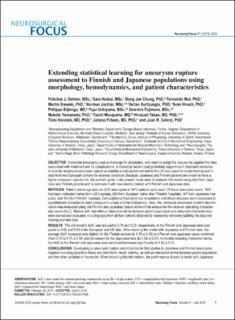Bitte benutzen Sie diese Kennung, um auf die Ressource zu verweisen:
https://doi.org/10.21256/zhaw-19549| Publikationstyp: | Beitrag in wissenschaftlicher Zeitschrift |
| Art der Begutachtung: | Peer review (Publikation) |
| Titel: | Extending statistical learning for aneurysm rupture assessment to Finnish and Japanese populations using morphology, hemodynamics, and patient characteristics |
| Autor/-in: | Detmer, Felicitas J. Hadad, Sara Chung, Bong Jae Mut, Fernando Slawski, Martin Juchler, Norman Kurtcuoglu, Vartan Hirsch, Sven Bijlenga, Philippe Uchiyama, Yuya Fujimura, Soichiro Yamamoto, Makoto Murayama, Yuichi Takao, Hiroyuki Koivisto, Timo Frösen, Juhana Cebral, Juan R. |
| et. al: | No |
| DOI: | 10.3171/2019.4.FOCUS19145 10.21256/zhaw-19549 |
| Erschienen in: | Neurosurgical Focus |
| Band(Heft): | 47 |
| Heft: | 1 |
| Erscheinungsdatum: | Jul-2019 |
| Verlag / Hrsg. Institution: | American Association of Neurological Surgeons |
| ISSN: | 1092-0684 |
| Sprache: | Englisch |
| Schlagwörter: | Cerebral aneurysm; Rupture risk; Hemodynamics; Morphology |
| Fachgebiet (DDC): | 616.8: Neurologie und Krankheiten des Nervensystems |
| Zusammenfassung: | OBJECTIVE: Incidental aneurysms pose a challenge for physicians, who need to weigh the rupture risk against the risks associated with treatment and its complications. A statistical model could potentially support such treatment decisions. A recently developed aneurysm rupture probability model performed well in the US data used for model training and in data from two European cohorts for external validation. Because Japanese and Finnish patients are known to have a higher aneurysm rupture risk, the authors’ goals in the present study were to evaluate this model using data from Japanese and Finnish patients and to compare it with new models trained with Finnish and Japanese data. METHODS: Patient and image data on 2129 aneurysms in 1472 patients were used. Of these aneurysm cases, 1631 had been collected mainly from US hospitals, 249 from European (other than Finnish) hospitals, 147 from Japanese hospitals, and 102 from Finnish hospitals. Computational fluid dynamics simulations and shape analyses were conducted to quantitatively characterize each aneurysm’s shape and hemodynamics. Next, the previously developed model’s discrimination was evaluated using the Finnish and Japanese data in terms of the area under the receiver operating characteristic curve (AUC). Models with and without interaction terms between patient population and aneurysm characteristics were trained and evaluated including data from all four cohorts obtained by repeatedly randomly splitting the data into training and test data. RESULTS: The US model’s AUC was reduced to 0.70 and 0.72, respectively, in the Finnish and Japanese data compared to 0.82 and 0.86 in the European and US data. When training the model with Japanese and Finnish data, the average AUC increased only slightly for the Finnish sample (to 0.76 ± 0.16) and Finnish and Japanese cases combined (from 0.74 to 0.75 ± 0.14) and decreased for the Japanese data (to 0.66 ± 0.33). In models including interaction terms, the AUC in the Finnish and Japanese data combined increased significantly to 0.83 ± 0.10. CONCLUSIONS: Developing an aneurysm rupture prediction model that applies to Japanese and Finnish aneurysms requires including data from these two cohorts for model training, as well as interaction terms between patient population and the other variables in the model. When including this information, the performance of such a model with Japanese and Finnish data is close to its performance with US or European data. These results suggest that population-specific differences determine how hemodynamics and shape associate with rupture risk in intracranial aneurysms. |
| URI: | https://digitalcollection.zhaw.ch/handle/11475/19549 |
| Volltext Version: | Publizierte Version |
| Lizenz (gemäss Verlagsvertrag): | Lizenz gemäss Verlagsvertrag |
| Departement: | Life Sciences und Facility Management |
| Organisationseinheit: | Institut für Computational Life Sciences (ICLS) |
| Publiziert im Rahmen des ZHAW-Projekts: | AneuX |
| Enthalten in den Sammlungen: | Publikationen Life Sciences und Facility Management |
Dateien zu dieser Ressource:
| Datei | Beschreibung | Größe | Format | |
|---|---|---|---|---|
| 2019_Juchler_Extending_statistical_learning_for_aneurysm_rupture_assessment_Neurosurgical_Focus.pdf | 9.57 MB | Adobe PDF |  Öffnen/Anzeigen |
Zur Langanzeige
Detmer, F. J., Hadad, S., Chung, B. J., Mut, F., Slawski, M., Juchler, N., Kurtcuoglu, V., Hirsch, S., Bijlenga, P., Uchiyama, Y., Fujimura, S., Yamamoto, M., Murayama, Y., Takao, H., Koivisto, T., Frösen, J., & Cebral, J. R. (2019). Extending statistical learning for aneurysm rupture assessment to Finnish and Japanese populations using morphology, hemodynamics, and patient characteristics. Neurosurgical Focus, 47(1). https://doi.org/10.3171/2019.4.FOCUS19145
Detmer, F.J. et al. (2019) ‘Extending statistical learning for aneurysm rupture assessment to Finnish and Japanese populations using morphology, hemodynamics, and patient characteristics’, Neurosurgical Focus, 47(1). Available at: https://doi.org/10.3171/2019.4.FOCUS19145.
F. J. Detmer et al., “Extending statistical learning for aneurysm rupture assessment to Finnish and Japanese populations using morphology, hemodynamics, and patient characteristics,” Neurosurgical Focus, vol. 47, no. 1, Jul. 2019, doi: 10.3171/2019.4.FOCUS19145.
DETMER, Felicitas J., Sara HADAD, Bong Jae CHUNG, Fernando MUT, Martin SLAWSKI, Norman JUCHLER, Vartan KURTCUOGLU, Sven HIRSCH, Philippe BIJLENGA, Yuya UCHIYAMA, Soichiro FUJIMURA, Makoto YAMAMOTO, Yuichi MURAYAMA, Hiroyuki TAKAO, Timo KOIVISTO, Juhana FRÖSEN und Juan R. CEBRAL, 2019. Extending statistical learning for aneurysm rupture assessment to Finnish and Japanese populations using morphology, hemodynamics, and patient characteristics. Neurosurgical Focus. Juli 2019. Bd. 47, Nr. 1. DOI 10.3171/2019.4.FOCUS19145
Detmer, Felicitas J., Sara Hadad, Bong Jae Chung, Fernando Mut, Martin Slawski, Norman Juchler, Vartan Kurtcuoglu, et al. 2019. “Extending Statistical Learning for Aneurysm Rupture Assessment to Finnish and Japanese Populations Using Morphology, Hemodynamics, and Patient Characteristics.” Neurosurgical Focus 47 (1). https://doi.org/10.3171/2019.4.FOCUS19145.
Detmer, Felicitas J., et al. “Extending Statistical Learning for Aneurysm Rupture Assessment to Finnish and Japanese Populations Using Morphology, Hemodynamics, and Patient Characteristics.” Neurosurgical Focus, vol. 47, no. 1, July 2019, https://doi.org/10.3171/2019.4.FOCUS19145.
Alle Ressourcen in diesem Repository sind urheberrechtlich geschützt, soweit nicht anderweitig angezeigt.